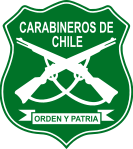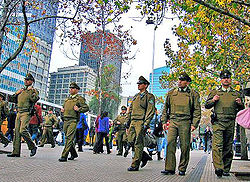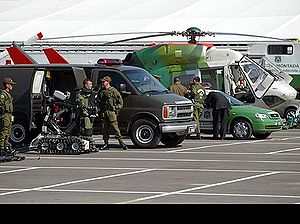- Carabineros de Chile
-
Carabiniers of Chile
Carabineros de ChileLogo of the Carabiniers of Chile. Motto Orden y Patria Order & Fatherland Agency overview Formed April 27, 1927 Preceding agency Cuerpo de Carabineros Legal personality Governmental: Government agency Jurisdictional structure National agency
(Operations jurisdiction)Chile Legal jurisdiction As per operations jurisdiction. General nature Operational structure Overviewed by Dirección General Headquarters Santiago de Chile Agency executive Gustavo González Jure, Director General Website www.carabineros.cl The Carabiniers of Chile, (Spanish:Carabineros de Chile) are the uniformed Chilean national police force and gendarmerie, created on April 27, 1927. Their mission is to maintain order and create public respect for the laws of the country. They report to the Ministerio de Defensa Nacional (Ministry of National Defense) through the Undersecretary of Carabiniers, but since 2011 the Ministry of the Interior and Public Security has full control over them, thus fully separating it from the three other branches by department but still considered a part of the armed forces. Chile also has an investigative police force, the Investigations Police of Chile, also under the Interior and Public Security Ministry.
Contents
History
The origins of the Carabiniers can be traced back to night watchmen such as the Dragones de la Reina (Queen's Dragoons) (created in 1758 and later renamed the Dragoons of Chile in 1812) and other organizations that fulfilled functions such as the watch and local policing.
Later, cities such as Santiago and Valparaíso created their own city police forces. In 1881 the Rural Police (Policía Rural) was created for the rural areas of the country. However, the main problem with these police services was that they were dependent on local authorities for day-to-day decision making. This led to local officials abusing this power for their own political ends. In 1896 the Policía Fiscal (Prosecuting Police) was created to serve the cities.
The first policing organization with the name "Carabiniers" was the Corps of Carabiniers, in Spanish Cuerpo de Carabineros (with similar meaning as the Italian Carabinieri), formed in 1903 to bring law and order to the Araucanía Region of Southern Chile (then much larger than today). In 1908 the Carabiniers' School (Escuela de Carabineros, currently located in Providencia) was created. In 1927, President Carlos Ibáñez del Campo merged the Fiscal Police (Policía Fiscal), the Rural Police (Policia Rural), and the existing Corps of Carabiniers to form the Carabiniers of Chile, one unified institution under the direction of the national government. The organization still carries the name given to it by Ibáñez, who became the Carabiniers' first Director General.
In 1973 the Carabiniers, headed by General Cesar Mendoza Duran, later appointed Director General, joined the Chilean coup of 1973 under the lead of the Army, Navy and Air Forces leaders, that overthrew President Salvador Allende. As such, the Carabiniers' commander was a formal member of the Military Government Junta (1973–1990), as well as members of the institution taking on administrative roles, such as being in charge of the Ministry of Education.
Today
The Carabiniers' current mission is to maintain or re-establish order and security in Chilean society through civic education, service to the community, police work, and in a war situation, to act as a military force (all their members have military training). Under the current Chilean constitution the Carabiniers are integrated directly into the armed forces in a state of emergency to better guarantee order. They also have a special armed police unit called the Special police operations Group (GOPE or Grupo de Operaciones Policiales Especiales). There is also an Elite Corps in charge of security in La Moneda Palace and for the President.
Aircraft inventory
The Carabiniers operate 35 aircraft in support of their operations, including 10 helicopters. Recently, 4 Augusta A109E [1] have been acquired.
Aircraft Origin Type Versions In service[2] Notes Agusta A109  Italy
Italyutility transport Agusta A109E 4 Bell 206  United States
United Statesutility helicopter 206B 1 Used for pilot training only. Cessna 182  United States
United Statesutility 182Q 5 Cessna 206  United States
United Statesutility 3 Cessna 208  United States
United Statesutility 1 Cessna 210  United States
United Statesutility transport 5 Cessna Citation  United States
United StatesVIP transport 550 Citation II 2 Eurocopter Bo 105  Germany
Germanyutility helicopter Bo 105C
Bo 105LSA-35
2Eurocopter EC 135  European Union
European Unionutility helicopter EC 135 T1 1 MBB/Kawasaki BK 117  Germany
Germany
 Japan
Japanutility helicopter BK117B-1 2 Piper PA-31 Navajo  United States
United Statesutility transport PA-31
PA-31T Cheyenne3
1Ranks of the Chilean Carabiniers
Enlisted personnel and Non-commissioned officers
Chilean and foreign NCOs enter the service through enrollment at the Carabiniers Formation School and receive further training as Corporals at the Carabiniers NCO Academy, both located in the Santiago Metropolitan Region, and some of them have later training at the various service schools of the Carabiniers specializing in frontier defense, horsemanship and K-9 training and handling skills.- Carabinero(Carabinier)
- Cabo Segundo (Second Corporal)
- Cabo Primero (First Corporal)
- Sargento Segundo (Sergeant)
- Sargento Primero (First Sergeant)
- Suboficial (Subofficer)
- Suboficial Mayor (Subofficer Major)
Commissioned officers
Officers of the Carabiners, native born or foreign officer having scholarships, start out as Officer Aspirants at the Carabinier Officers School "Pres. Gen. Carlos Ibanez del Campo" in Santiago, and after graduating become Sublieutenants either in Chile or in their home countries. Later training is provided by the Police Sciences Academy also in Santiago, and in the aforementioned specialty schools of the force.- Aspirante a oficial (Officer Aspirant)
- Subteniente (Sublieutenant)
- Teniente (Lieutenant)
- Capitan (Captain)
- Mayor (Major)
- Teniente Coronel (Lieutenant Colonel)
- Coronel (Colonel)
- General (General)
- General Inspector (General Inspector)
- General Director (General Director)
References
- ^ Entrega de 2 helicopteros en presencia de la Presidenta
- ^ "World Military Aircraft Inventory", Aerospace Source Book 2007, Aviation Week & Space Technology, January 15, 2007.
External links

Law enforcement in South America Sovereign states Dependencies and
other territories- Aruba
- Bonaire
- Curaçao
- Falkland Islands
- French Guiana
- Categories:
- National law enforcement agencies of Chile
- Gendarmerie
- Government of Chile
Wikimedia Foundation. 2010.
Look at other dictionaries:
Carabineros de Chile — Activa 1927 en adelante País … Wikipedia Español
Carabineros De Chile — Directeur général General de Carabineros, don Eduardo Gordon Valcárcel Fondée 27 avril 1927. Site Web (es) Carabineros de Chile … Wikipédia en Français
Carabineros de chile — Directeur général General de Carabineros, don Eduardo Gordon Valcárcel Fondée 27 avril 1927. Site Web (es) Carabineros de Chile … Wikipédia en Français
Carabineros de Chile — es la policía uniformada nacional de Chile creada el 27 de abril de 1927. Su misión es salvaguardar el orden público y hacer respetar las leyes. Depende administrativamente del Ministerio Defensa Nacional por medio de la subsecretaria de… … Enciclopedia Universal
Carabineros de Chile — Carabiniers du Chili Période 27 avril 1927 Pays … Wikipédia en Français
General director de Carabineros de Chile — Galones de general director en el uniforme de Carabineros de Chile. General director es un rango existente en Carabineros de Chile. El grado de General Director corresponde al oficial general de Carabineros de Chile que desempeña el cargo de… … Wikipedia Español
Escuela de Carabineros de Chile — Saltar a navegación, búsqueda Escuela de Carabineros de Chile del General Carlos Ibáñez del Campo. Director Coronel Víctor Hugo Herrera Pintor Fundada el 19 de diciembre de 1908. Marcha Oficial Parada de los Hombres Altos de Marc Roland. Sitio… … Wikipedia Español
Guardia de Palacio de Carabineros de Chile — custodia la puerta de La Moneda. La Guardia de Palacio es una unidad perteneciente a Carabineros de Chile, dependiente del Departamento de Seguridad Presidencial, que se desempeña como guardia del palacio de gobierno, escolta presidencial y,… … Wikipedia Español
General Director de Carabineros de Chile — Saltar a navegación, búsqueda Galones de General Director en el uniforme de Carabineros de Chile. General Director es un rango existente en Carabineros de Chile. El grado de General Director corresponde al oficial general de Carabineros de Chile… … Wikipedia Español
Controversias relacionadas con Carabineros de Chile — Existen desacuerdos sobre la neutralidad en el punto de vista de la versión actual de este artículo o sección. En la página de discusión puedes consultar el debate al respecto … Wikipedia Español



